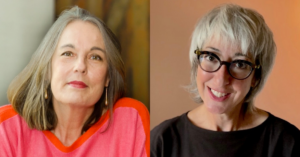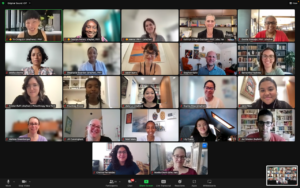4 min read
Emotion and the Search for Meaning at SXSW

This piece was originally published in 2012 on Philanthropy News Digest.
I just returned from the South by Southwest Interactive conference (SXSW), where I participated in a panel on applying story and narrative in organizations. I went to SXSW looking to explore my contention that, in an increasingly loud, complex, and data-saturated world, a smart leader’s role is not to add more information but to communicate meaning. That certainly was the subtext of a fascinating discussion I sat in on titled “Maps of Time: Data as Narrative.”
During the discussion, Burt Herman, co-founder of Storify, the popular social media curation tool, argued that because “every story is not perfectly understood in the moment,” the use of algorithms to mine user data is a perfectly legitimate way to help people decide what’s important. Pushing back a bit on Herman’s point, Jenn Thom, a research scientist at IBM’s Visual Communication Lab, noted that “the algorithms we create to sift through data are not apolitical.” And Drew Harry, Ph.D. candidate at the MIT Media Lab, presented a program he is developing that helps people decide in real time what is and isn’t important.
But it was panelist Nicola Hughes, a Knight-Mozilla Fellow, who said something that really electrified me, perfectly capturing what in my opinion was the real theme of this year’s SXSW Interactive conference: that true social and technological innovation requires the marriage of offline and online activities, the combination of the digital and the human. Hughes noted that when people are trying to make sense of news in the moment — think of trending stories on Twitter — “untruths can travel far.” Is sense-making then, true to what actually happened or why it happened? And, she added by way of warning, because all of us are producing and being exposed to a lot more of “It” (data, news, and information in narrative form), “we’re going to be getting ‘It’ wrong more often.”
In a conversation after the panel discussion, Hughes told me that “journalists will be the archeologists of the future. They will have to sift through big data to try to make sense of it all.” I then shared with her my belief that there are always four stories: the story you tell; the story you hear; the story that is the truth; and the story you are not hearing. Nicola explained that, in the technological realm, the fourth story is referred to as “unknown knowledge.”
The exchange was indicative of the undercurrent of “meaning-making” that ran through this year’s conference. In addition to many panels on the use of technology for social good, there was a focus on what “Buddhist Geek” Vincent Horn calls the “collectivization of intent.” Indeed, during a panel discussion titled “Closer to One: Buddhism and the Internet of Things,” Matt Rolandson, of the design company Ammunition Group, asked the important question: “Now that anything is possible, what is worth making possible? What is meaningful?”
David Womack, creative director of interactive design at R/GA and a professor at the School of Visual and Performing Arts, led an equally compelling session titled “Does Your Product Have a Plot?” During the session, Womack stressed the importance of adding emotional complexity to product design so as to foster deeper customer engagement. I understood him in part to be saying that we all must demonstrate a deep regard for our customers and partners, that people are highly complex and emotional, and that it is a sign of respect to offer them content that emphatically reflects this complexity.
The goal, said Womack, is emotional rather than product complexity, and he provided several examples to illustrate his point:
- Amazon adding product reviews and, more recently, social sharing. According to Womack, Amazon is okay with a certain level of customer confusion because it keeps people coming back to the site, improving the odds they’ll eventually buy something. As for negative product reviews, don’t sweat ’em. Even if people are sharing negative stories about your product, said Womack, they are contributing complexity to the system, which serves to keep others interested.
- The Tiffany Love Stories campaign, which Womack designed. Prior to the campaign, Tiffany didn’t know whether people would be willing to share highly emotional stories of falling in love. But today, there are more than forty thousand such stories on the site. Why? Because, said Womack, by adding photos and then video, Tiffany ratcheted up the emotional complexity of the campaign, which kept people more engaged.
- And, finally, Apple — because, said Womack, they infuse technologically complex products with emotion (think of the blinking, “breathing” on/off light on a Mac), which helps to make them seem less complex.
In closing, Womack delivered two statements with relevance for the nonprofit sector: “Products that provide a platform for stories will be the ones that stick around.” And, “We are lucky enough to live in complicated and interesting times for storytelling.”
Thaler Pekar & Partners is internationally-recognized for its deep expertise in narrative, story, and communication. Both the BBC and the Smithsonian Institution have hailed the founder, Thaler Pekar, as one of the world’s leading experts on institutional storytelling.
For 14 years, the team at Thaler Pekar & Partners has advised visionaries on being understood and influential. Our trademarked communication processes — Heart, Head, & Hand®, Engagement Equation® and Invitational Incline® — provide leaders with the confidence to speak, listen, and be heard, and sustain them in offering effective motivation. As a result, teams are more productive, audiences are more receptive, and visibility increases.
Our award-winning work ranges from gathering 178 oral histories across four continents and six countries for Chuck Feeney’s The Atlantic Philanthropies; to finding and refining stories about integrity for Novartis senior leadership; to coaching a mainstage TED Talker; and to developing a communication and story skills academy for L’Oreál International Educators and Customer Representatives.







